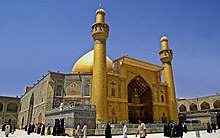
Back الشيعة في العراق Arabic ইরাকে শিয়া মতাদর্শী ইসলাম Bengali/Bangla شیعە لە عێراق CKB شیعیان عراق Persian
شيعة العراق | |
|---|---|
 Imam Ali Mosque, Najaf. One of the holiest sites in Shia Islam. | |
| Total population | |
| 55–60% of the Iraqi population | |
| Languages | |
| Arabic (majority), Feyli Kurdish and Iraqi Turkmen (minority) | |
| Religion | |
| Shia Islam (Twelver) | |
| Related ethnic groups | |
| Semitic peoples, Iranian peoples, Turkish peoples |
Shia Islam in Iraq (Arabic: الشيعة في العراق) has a history going back to the times of Ali ibn Abi Talib, the first imam of Shia Islam and fourth caliph of Sunni Islam who moved the capital of the early caliphate from Medina to Kufa (or Najaf) two decades after the death of Muhammad. In 2015, Shia Muslims made up between 55% and 60% of the Iraqi population.[1] Iraq is the location of the holy cities of Najaf and Karbala, pilgrimage sites for millions of Shia Muslims.
Najaf is the site of Ali's tomb, and Karbala is the site of the tomb of Muhammad's grandson, third Shia imam Husayn ibn Ali. Najaf is also a center of Shia learning and seminaries. Two other holy sites for Twelver Shia in Iraq are the Al-Kadhimiya Mosque in Baghdad, which contains the tombs of the seventh and ninth Shia Imams (Mūsā al-Kādhim and Muhammad al-Jawad) and the Al-Askari Mosque in Sāmarrā, which contains the tombs of the tenth and eleventh Shia Imams (Ali al-Hadi and Hasan al-‘Askarī).
After the U.S.-led invasion in 2003, widespread sectarian violence erupted between Shias and Sunnis in Iraq, which led to the Iraqi civil war and the 2013–2017 war, which involved the Islamic State terror group.
- ^ "Religious Politics in Iraq". United States Institute of Peace. Retrieved 2024-01-30.